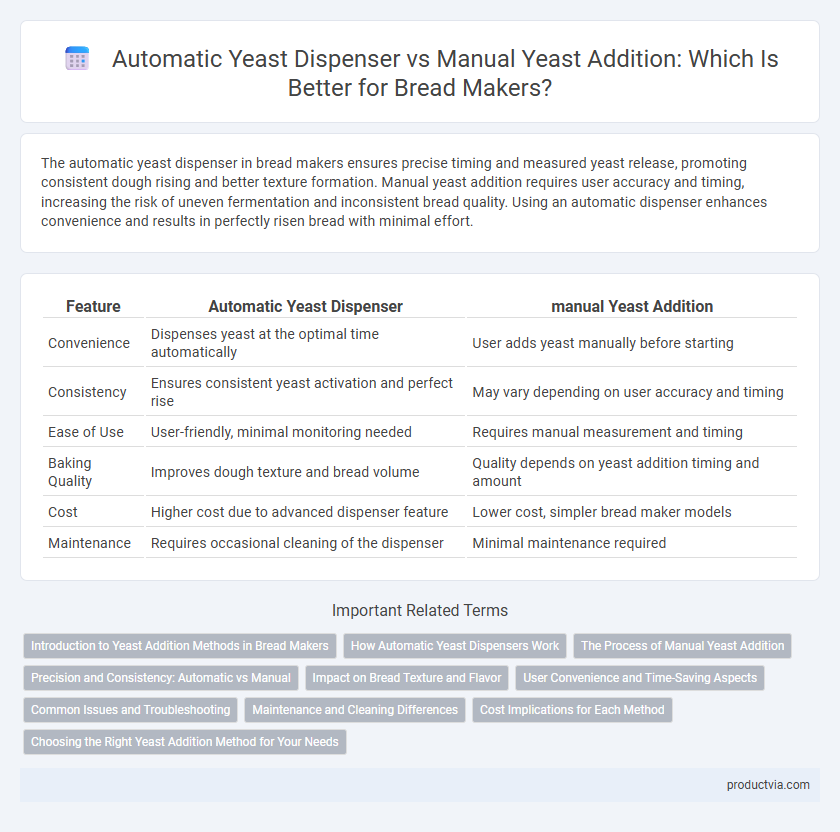The automatic yeast dispenser in bread makers ensures precise timing and measured yeast release, promoting consistent dough rising and better texture formation. Manual yeast addition requires user accuracy and timing, increasing the risk of uneven fermentation and inconsistent bread quality. Using an automatic dispenser enhances convenience and results in perfectly risen bread with minimal effort.
Table of Comparison
| Feature | Automatic Yeast Dispenser | manual Yeast Addition |
|---|---|---|
| Convenience | Dispenses yeast at the optimal time automatically | User adds yeast manually before starting |
| Consistency | Ensures consistent yeast activation and perfect rise | May vary depending on user accuracy and timing |
| Ease of Use | User-friendly, minimal monitoring needed | Requires manual measurement and timing |
| Baking Quality | Improves dough texture and bread volume | Quality depends on yeast addition timing and amount |
| Cost | Higher cost due to advanced dispenser feature | Lower cost, simpler bread maker models |
| Maintenance | Requires occasional cleaning of the dispenser | Minimal maintenance required |
Introduction to Yeast Addition Methods in Bread Makers
Automatic yeast dispensers in bread makers enhance consistency by releasing yeast at precise intervals, ensuring optimal fermentation and improved loaf quality. Manual yeast addition requires careful timing and measurement by the user, which can lead to variability in dough texture and rise. Choosing the right method impacts the bread-making process, influencing final taste, crumb structure, and overall baking success.
How Automatic Yeast Dispensers Work
Automatic yeast dispensers in bread makers precisely release yeast at the ideal stage in the baking cycle, ensuring optimal fermentation and consistent bread quality. These dispensers use a timing mechanism synchronized with the kneading and rising processes to prevent premature yeast activation. By controlling yeast addition automatically, they enhance dough texture and improve loaf volume without requiring user intervention.
The Process of Manual Yeast Addition
Manual yeast addition in bread makers requires the user to measure and add yeast directly to the dough ingredients at the start of the baking cycle, which can risk premature yeast activation or inconsistent fermentation. This process demands precise timing and accurate yeast quantity to avoid affecting dough rise and bread texture. Unlike automatic yeast dispensers that release yeast at optimal times, manual addition relies entirely on user expertise to ensure proper dough development.
Precision and Consistency: Automatic vs Manual
Automatic yeast dispensers in bread makers ensure precise and consistent yeast measurement by releasing the exact amount at the optimal time, enhancing dough rise and bread texture. Manual yeast addition relies on user accuracy, which can vary and lead to inconsistencies in fermentation and overall bread quality. Precision in yeast dispensing directly affects the uniformity of bread crumb structure and flavor development.
Impact on Bread Texture and Flavor
An automatic yeast dispenser in bread makers ensures precise yeast release timing, which promotes optimal dough fermentation and results in consistent bread texture with a fine crumb structure. Manual yeast addition can lead to variability in yeast distribution, potentially causing uneven fermentation and denser, less uniform bread texture. The controlled yeast activation from automatic dispensers often enhances flavor development by allowing yeast to ferment sugars effectively, producing richer, more complex bread aromas.
User Convenience and Time-Saving Aspects
Automatic yeast dispensers in bread makers enhance user convenience by precisely releasing yeast at the optimal time, preventing premature fermentation and reducing user intervention. This feature saves time by eliminating the need for manual yeast measurement and addition, streamlining the baking process for both beginners and experienced bakers. In contrast, manual yeast addition requires careful timing and may lead to inconsistent results, increasing the potential for user error and extended preparation time.
Common Issues and Troubleshooting
Automatic yeast dispensers in bread makers prevent yeast from contacting other ingredients prematurely, reducing the risk of dough overproofing or flat bread; common issues include dispenser clogs or misalignment causing yeast not to release properly. Manual yeast addition requires precise timing and measurement to avoid yeast inactivity or excessive fermentation, often leading to inconsistent dough texture or improper rising. Troubleshooting automatic dispensers involves cleaning and ensuring proper loading, while manual addition issues are resolved by following recipe timings strictly and verifying yeast freshness.
Maintenance and Cleaning Differences
Automatic yeast dispensers in bread makers reduce the risk of yeast clumping and ensure timely yeast release, requiring occasional cleaning of the dispenser mechanism to prevent buildup. Manual yeast addition simplifies maintenance by eliminating mechanical parts but demands careful measuring and immediate mixing to avoid yeast exposure to moisture. Regular cleaning of the bread pan and kneading paddle remains essential in both methods to maintain optimal machine performance and bread quality.
Cost Implications for Each Method
Automatic yeast dispensers in bread makers typically increase upfront costs due to added mechanical complexity and advanced technology, but they ensure precise yeast measurement, reducing ingredient waste over time. Manual yeast addition, while more budget-friendly initially, risks inconsistent yeast amounts, potentially leading to uneven fermentation and increased ingredient costs or product waste. Choosing between the two methods involves balancing initial investment against long-term savings from ingredient efficiency and consistent baking results.
Choosing the Right Yeast Addition Method for Your Needs
Automatic yeast dispensers ensure precise timing and optimal yeast activation, leading to consistent loaf quality and improved bread texture. Manual yeast addition offers greater flexibility for experimenting with yeast types and adjusting quantities based on specific recipes or personal preferences. Selecting between automatic and manual yeast addition depends on your desire for convenience and consistency versus customization in bread-making.
Automatic yeast dispenser vs Manual yeast addition for bread makers Infographic

 productvia.com
productvia.com